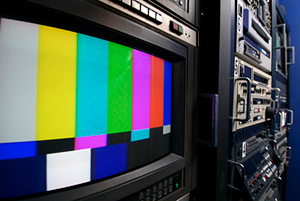Latency Means Late

Many years ago I worked as a news photographer (16mm film) at the ABC affiliate in Seattle, and I was able to witness intentional latency from a front row seat.
Webster's New Collegiate Dictionary defines latency as the quality or condition of being latent, which in turn is defined as "present and capable of becoming, though not yet visible or active."
That would describe my experience with latency to a "T." We received the live feed of Monday Night Football beginning at 6 p.m. Pacific Time (9 p.m. Eastern Time), but delayed the start until 7 p.m. our time in order to allow our newscasts to air.
THE OLD DAYS
In that this was during the pre-Internet days, we'd get dozens of calls to the newsroom asking what the score actually was, an hour ahead of when that particular portion of the game would air on our station. I'm guessing this would allow some people to bet on a sure thing. I know that some of my cohorts got so tired of fielding the calls that they would occasionally make up scores to give the callers. I suppose we were lucky the station wasn't burned down in retaliation.
An hour delay for a program was nowhere near a record in those earlier days of television. Before satellite delivery of syndicated programming, shows like "The Mike Douglas Show" were "bicycled" from one station to the next via Greyhound.
The original episode was videotaped, and dubbed to a number of copies that were shipped to the larger market stations. After airing that episode, the larger station bussed the tape to the next station in line, and so on and so forth. In a smaller market the show would air many weeks later. I don't know of any actual cases of this, but I would imagine that some of the guests had died by the time the episode was viewed at a 200-plus market station.
Latency in production today may be measured in much smaller periods of time, fractions of a second. But those milliseconds can have profound effects on program execution. When evaluating a piece of equipment, latency is often something to consider.
LATENCY TODAY
Take the case of a remote camera. If you're using a joystick and you push it to the left, the camera moves to the left. The way you know that the camera is moving to the left is that the video return feed from the camera shows the camera-view moving to the left. When you return the joystick to the center, the camera-view stops moving.
Now introduce one second of latency into the system, either on the control path out to the camera, or on the return video feed. Now it takes one second for the camera-view to start moving after deflecting the joystick. That's not nearly as big a problem as when you want to stop moving the camera—the camera-view will continue to move for one second after the joystick is returned to the center.

©iStockphoto/David H. Lewis It sounds pretty difficult to operate. So if I was buying a remote camera system, I'd want to look all the way through the control and return video path to make certain I had no latency or at least an amount so small that I could live with it.
What about an intercom system? If the camera operator hears a director's instruction a few milliseconds after it is spoken, then the instruction can be carried out in a relatively timely fashion. If that operator hears it a second or so after the instruction is given, there will be at least that period of delay until the command is followed. (We've all known operators where a certain amount of latency was built into their brain, but that's another subject.)
What about if what the director sees in his monitoring is delayed? That close-up shot of a hike works pretty good if he takes to a wider shot immediately after the ball is snapped. If it's a half second late, he's missed the beginning of the play. So if the director isn't viewing the game almost exactly live, then he's going to be a step behind all game long. Questions about latency in a monitoring system are well-asked.
ALWAYS ASK
Video processing and audio processing can each add to latency. There, if video or audio is just a few frames later than their counterpart, you have the maddening problem of lip-sync errors, which are epidemic in television today. But that's food for another column or 10.
Each individual increment of latency may not, in itself, be enough to be a problem. But some latency, plus some more latency, plus some more equals a lot of latency. So as a buyer, ask about latency at every step of the signal path.
And don't even ask me about the days when the NBC affiliate I worked at would kinescope (take a movie of a TV screen) of the network evening newscast to send it off to Alaska. That was some kinda latency.
Craig Johnston is a Seattle-based Internet and multimedia producer with an extensive background in broadcast. He can be reached atcraig@craigjohnston.com.
Get the TV Tech Newsletter
The professional video industry's #1 source for news, trends and product and tech information. Sign up below.
